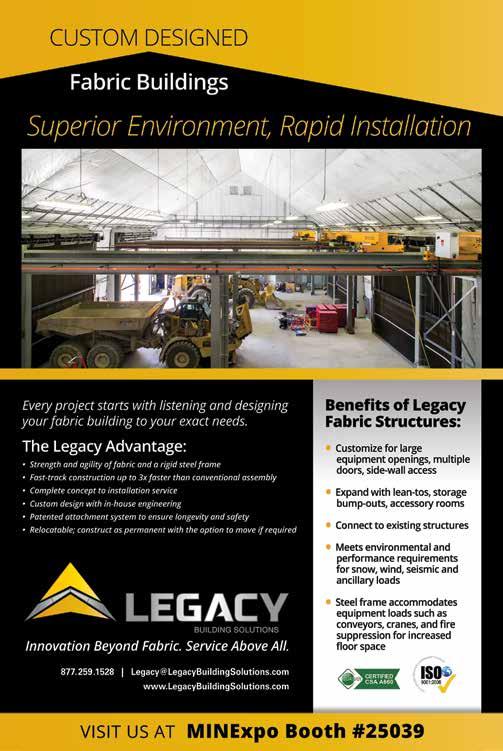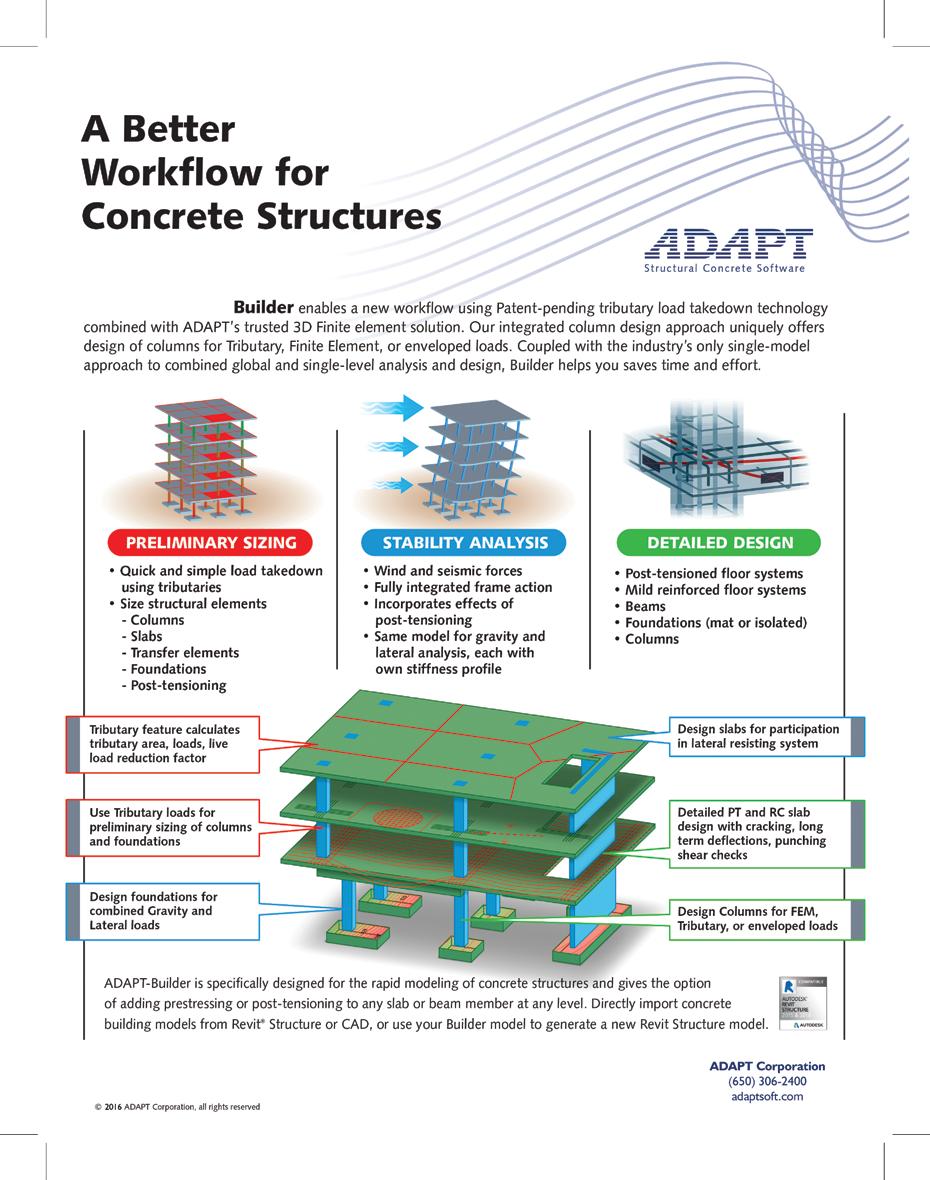
5 minute read
ENGINEER’S NOTEBOOK
Flexure Design of Built-up Box Beams
By Roger LaBoube, Ph.D., P.E.
Abox beam confguration may be used at openings in a foor or wall framing assembly. Te American Iron and Steel Institute’s AISI S100 contains design provisions for built-up fexural members consisting of two C-sections oriented back-to-back to form an I-shaped section, i.e. Section D1.1, but does not contain design guidance for a box-section formed by orienting two C-sections lip-to-lip. For built-up members to act as a single composite unit, the members must be connected with sufcient fasteners at the maximum spacing as calculated below. Tis article illustrates the extrapolation of S100 Section D1.1 provisions to a box beam confguration. Te AISI S100 provisions are based on stabilizing the shear fow in the fanges. Te same shear fow exists in a box-shaped section; therefore, the S100 provisions could apply to form a box-shaped section with the two C-sections oriented lip-to-lip. Te AISI S100 provisions for Flexural Members Composed of Two Back-to-Back C-Sections (D1.1) are as follows: Te maximum longitudinal spacing of connections (one or more welds or other connectors), smax, joining two C-sections to form an I-section shall be: smax = L / 6 or 2gTs mq , whichever is smaller (Eq. D1.1-1) where L = Span of beam g = Vertical distance between two rows of connections nearest to top and bottom fanges Ts = Available strength [factored resistance] of connection in tension (Chapter E) m = Distance from shear center of one
C-section to mid-plane of web q = Design load [factored load] on beam for determining the longitudinal spacing of connections. Te D1.1 provisions, Eq. D1.1-1, defne the fastener spacing along the length of the member (Figure 1). Because the current D1.1 provisions are intended to stabilize the C-section and achieve equilibrium of the cross section for the single C-section (Figure 2), the D1.1 provisions may be adapted to box-shaped sections by recognizing that “g” is the vertical distance between the two rows of welds that interconnect the
Figure 1. Figure C-D1.1-2 (AISI S100C).
two C-sections. To evaluate “Ts”, the available strength of the welded connection, the provisions of AISI S100 Section E2.6, Equation E2.6-1, for fare groove welds applies. Using ASD, the safety factor is 2.55, and the nominal strength is as follows: Pn = 0.833 t L Fu (Eq. E2.5-1) Where, t is the thickness of the C-section, L is the length of the weld and Fu is the tensile strength of the C-section. Additional limit states that must be considered in the design of a fexural member are further defned in the AISI S100 provisions and include Bending, Shear, Combined Bending and Shear, Web Crippling, and Combined Bending and Web Crippling. Te following example illustrates the design steps for a built-up box beam. Check Bending Alone (Section C3.1.2.2): Te two interconnected C-sections are assumed to behave as a closed box member. Because for a closed box member in bending, lateral buckling is unlikely, the AISI Specifcation frst requires the evaluation of the critical unbraced length for which overall buckling is not a limit state. Tis design check is achieved by evaluation of the following equation: Lu = 0.36C FySf bπ √EGJIy If the span length is less than Lu, no intermediate braces are required to achieve the yield moment as computed by Section C3.1.1 of the AISI specifcation, Maxo = Sxe Fy / Ω Check Shear Alone (Section C3.2): For cold-formed steel members, shear alone is typically not a controlling limit state. However, the available shear capacity per web may be computed based on the limit states of shear yielding, shear inelastic buckling or shear elastic buckling. Because of the thin web material, buckling is the controlling shear limit state. Combined Bending and Shear (Section C3.3): For continuous span members, the combination of high shear and bending stresses may occur at intermediate supports. Tus, this limit state is an important design check for continuous span beams. Web Crippling Alone (Section C3.4): If the box beam is uniformly loaded, web crippling need only be considered at the end support. Web crippling must be considered if the box beam is supported on its bottom fange, and no web stifener or clip is provided at the support location. When checking web crippling, AISI Eq. C3.4.1-1 is applicable. Te appropriate coeffcients and safety factor are provided in Table C3.4.1-2. Te coefcients and safety factor tabulated in Table C3.4.1-1 are not appropriate because these coefcients, although indicated to be valid for “built-up sections,” were experimentally developed for only I-shaped sections. Combined Bending and Web Crippling (Section C3.5): For continuous span members, the combination of high compression stresses resulting from concentrated loads and bending stresses may occur at intermediate supports. Tus, this limit state is an important design check for continuous span beams.
Figure 3. Typical boxshaped cross section. the application of Section D1.1 for a back-toback confguration, see page 303 of Cold-Formed Steel Design (Yu and LaBoube, 2010).▪
Te online version of this article contains detailed references. Please visit www.STRUCTUREmag.org.
Check the Interconnection of the Two C-sections (Section D1.1): To interconnect the two C-sections forming a box beam confguration, fare groove welds are commonly used to interconnect the fanges (Figures 3 and 4). Te available strength of a fare groove weld can be computed using AISI Section E2.6. Te maximum longitudinal spacing for the welds, smax, as defned by AISI Section D1.1 is the lesser of smax = L / 6 or 2gTs mq (Eq. D1.1-1) Although not required by Section D1.1, it is suggested that the maximum unbraced length, Lu, to achieve the yield moment, Maxo, for the single C-section be considered. Te author suggests that Lu is considered to ensure that the weld spacing is less than the unbraced length to preclude overall buckling of the single C-section between the welds. Te AISI S100 Commentary provides an equation for Lu (Eq. C-C3.1.2.1-11). Te evaluated Lu should be greater than smax. For a numerical example problem illustrating the design of a welded box beam, refer to Cold-Formed Steel Engineers Institute TN G104-14, www.cfsei.org. For a numerical example problem illustrating
Tis article was originally published in CFSEI Tech Note, July 2014, Welded Box Beam Flexure Design, and is reprinted with permission. Roger LaBoube is Curator’s Teaching Professor Emeritus of Civil Engineering and Director of the Wei-Wen Yu Center for Cold-Formed Steel Structures at the Missouri University of Technology. Roger is active in several professional organizations and societies, including the American Iron and Steel Institute’s Committee on Specifcations and Committee on Framing Standards. He also serves on STRUCTURE’s Editorial Board. He can be reached at laboube@mst.edu.









